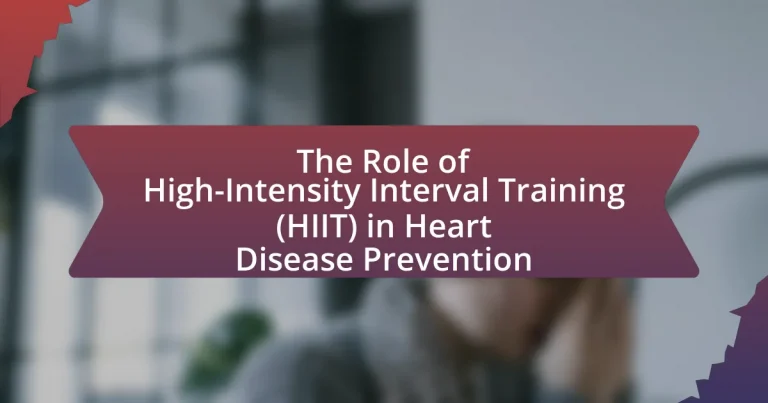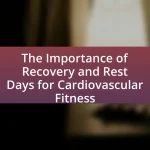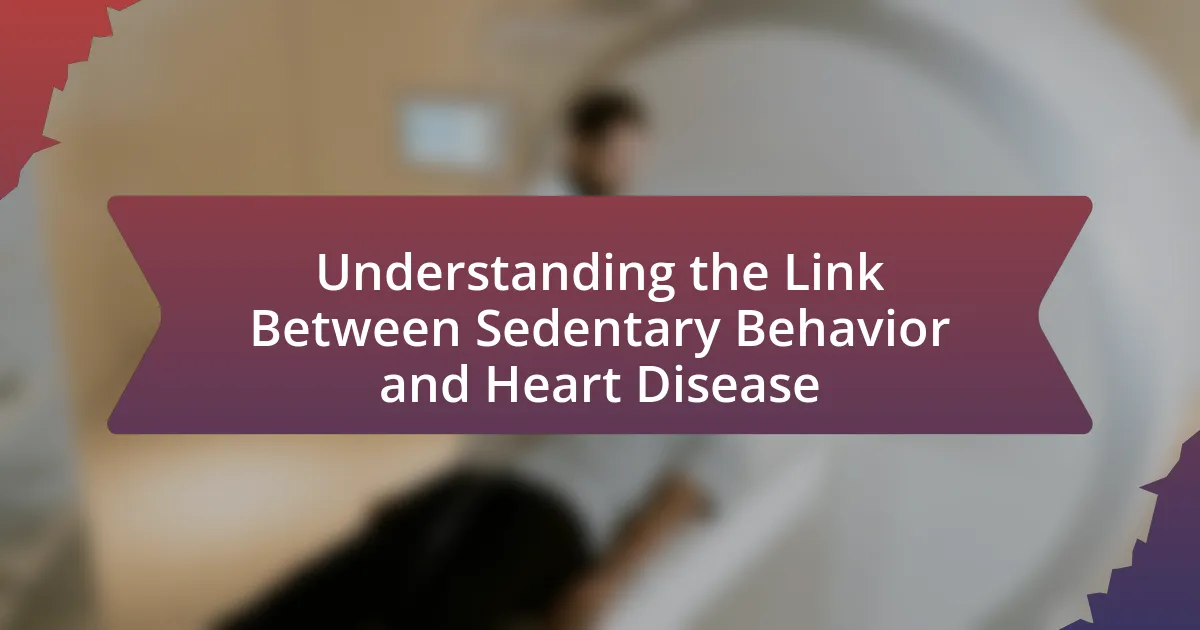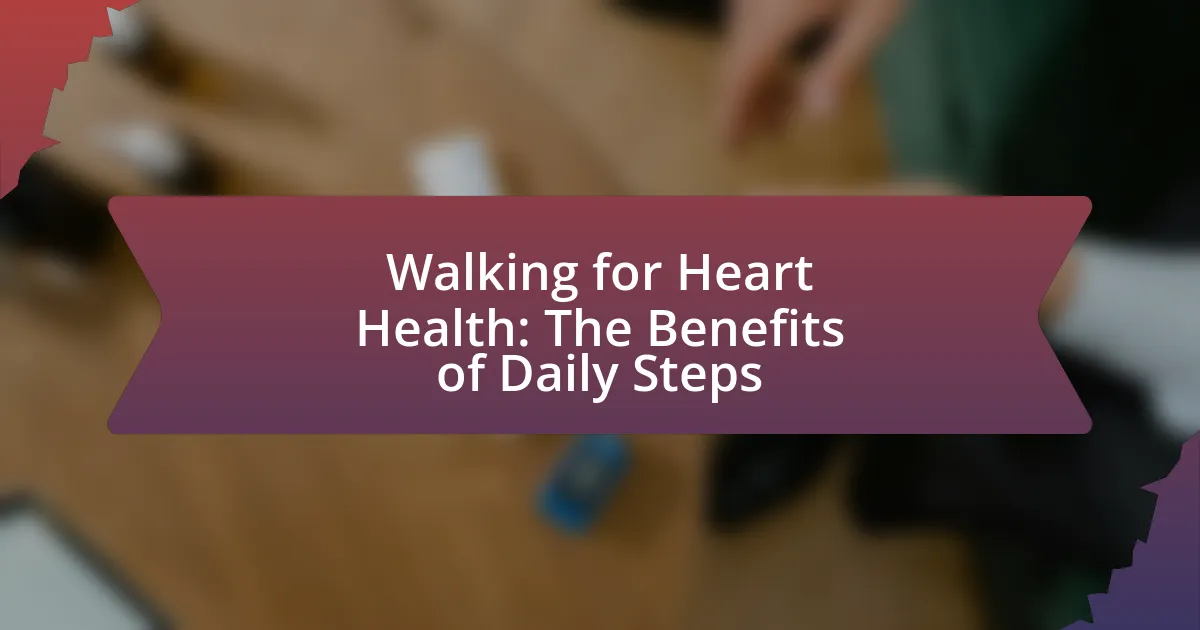High-Intensity Interval Training (HIIT) is a structured exercise method that alternates between short bursts of intense activity and periods of rest or lower-intensity exercise, proving to be highly relevant in heart disease prevention. Research indicates that HIIT enhances cardiovascular health by improving heart function, reducing blood pressure, and positively affecting lipid profiles, leading to significant reductions in body fat and improved insulin sensitivity. The article explores the differences between HIIT and traditional exercise methods, the physiological benefits of HIIT for heart health, and the scientific evidence supporting its effectiveness in reducing cardiovascular risk factors. Additionally, it addresses guidelines for safely incorporating HIIT into a fitness routine, potential risks, and the psychological benefits associated with this training approach.
-and-its-relevance-to-heart-disease-prevention-1.webp)
What is High-Intensity Interval Training (HIIT) and its relevance to heart disease prevention?
High-Intensity Interval Training (HIIT) is a form of exercise that alternates short bursts of intense activity with periods of rest or lower-intensity exercise. HIIT is relevant to heart disease prevention because it has been shown to improve cardiovascular health by enhancing heart function, reducing blood pressure, and improving lipid profiles. Research indicates that HIIT can lead to significant reductions in body fat and improvements in insulin sensitivity, both of which are risk factors for heart disease. A study published in the Journal of the American College of Cardiology found that individuals who engaged in HIIT experienced greater improvements in cardiovascular fitness compared to those who performed moderate-intensity continuous exercise, highlighting its effectiveness in promoting heart health.
How does HIIT differ from traditional exercise methods?
High-Intensity Interval Training (HIIT) differs from traditional exercise methods primarily in its structure and intensity. HIIT involves short bursts of intense activity followed by rest or low-intensity periods, typically lasting from 20 seconds to a few minutes, while traditional exercise methods often consist of steady-state, moderate-intensity workouts lasting longer durations, such as 30 minutes of continuous jogging. Research indicates that HIIT can lead to greater improvements in cardiovascular fitness and metabolic health in a shorter amount of time compared to traditional methods, as evidenced by a study published in the Journal of Obesity, which found that participants engaging in HIIT experienced a 25-30% greater reduction in body fat compared to those performing moderate-intensity continuous training over the same period.
What are the key characteristics of HIIT?
High-Intensity Interval Training (HIIT) is characterized by short bursts of intense exercise followed by brief recovery periods. This training method typically involves intervals lasting from 20 seconds to several minutes, with intensity levels reaching 80-95% of an individual’s maximum heart rate. Research indicates that HIIT can improve cardiovascular fitness, enhance metabolic health, and promote fat loss more effectively than traditional steady-state exercise. Studies, such as those published in the Journal of Obesity, demonstrate that HIIT can lead to significant improvements in aerobic capacity and insulin sensitivity, making it a potent tool for heart disease prevention.
Why is HIIT considered effective for cardiovascular health?
HIIT is considered effective for cardiovascular health because it significantly improves heart function and increases cardiovascular fitness in a shorter duration compared to traditional steady-state exercise. Studies have shown that HIIT can lead to greater reductions in body fat and improvements in insulin sensitivity, both of which are critical factors in reducing the risk of heart disease. For instance, a meta-analysis published in the British Journal of Sports Medicine found that HIIT resulted in a 10% greater improvement in VO2 max, a key indicator of cardiovascular fitness, compared to moderate-intensity continuous training. This enhanced cardiovascular response is attributed to the intense bursts of activity that elevate heart rate and promote better blood circulation, ultimately leading to improved heart health.
What is the relationship between exercise intensity and heart health?
Exercise intensity has a direct relationship with heart health, where higher intensity workouts can lead to improved cardiovascular fitness and reduced risk of heart disease. Engaging in vigorous exercise increases heart rate and promotes better blood circulation, which strengthens the heart muscle and enhances its efficiency. Research indicates that individuals who participate in high-intensity interval training (HIIT) experience significant improvements in cardiovascular health markers, such as lower blood pressure and improved cholesterol levels. A study published in the Journal of the American College of Cardiology found that HIIT can reduce the risk of heart disease by improving endothelial function and reducing arterial stiffness, demonstrating the beneficial effects of higher exercise intensity on heart health.
How does exercise intensity impact cardiovascular risk factors?
Exercise intensity significantly impacts cardiovascular risk factors by influencing heart rate, blood pressure, and lipid profiles. Higher intensity exercise, such as high-intensity interval training (HIIT), has been shown to improve cardiovascular health more effectively than moderate-intensity exercise. For instance, a study published in the Journal of the American College of Cardiology found that individuals engaging in HIIT experienced greater reductions in body fat and improved insulin sensitivity, which are critical factors in reducing cardiovascular disease risk. Additionally, research indicates that vigorous exercise can lead to lower resting blood pressure and improved cholesterol levels, further mitigating cardiovascular risks.
What role does HIIT play in improving heart function?
High-Intensity Interval Training (HIIT) significantly improves heart function by enhancing cardiovascular efficiency and promoting heart health. Research indicates that HIIT increases the heart’s stroke volume and cardiac output, leading to better oxygen delivery throughout the body. A study published in the Journal of the American College of Cardiology found that participants engaging in HIIT showed a 20% improvement in aerobic capacity compared to those who performed moderate-intensity continuous training. This improvement in aerobic capacity is directly linked to enhanced heart function, as it indicates the heart’s ability to pump blood more effectively during physical activity.
What scientific evidence supports HIIT for heart disease prevention?
High-Intensity Interval Training (HIIT) is supported by scientific evidence as an effective method for heart disease prevention. Research published in the Journal of the American College of Cardiology indicates that HIIT improves cardiovascular health by enhancing endothelial function, reducing arterial stiffness, and lowering blood pressure. A study by Kemi et al. (2014) demonstrated that participants engaging in HIIT showed significant improvements in VO2 max and overall cardiovascular fitness compared to those performing moderate-intensity continuous training. Additionally, a meta-analysis in the British Journal of Sports Medicine found that HIIT significantly reduced body fat and improved metabolic markers associated with heart disease risk. These findings collectively underscore the efficacy of HIIT in promoting heart health and preventing cardiovascular diseases.
What studies have been conducted on HIIT and heart disease outcomes?
Numerous studies have investigated the effects of High-Intensity Interval Training (HIIT) on heart disease outcomes, demonstrating its potential benefits. For instance, a meta-analysis published in the Journal of the American College of Cardiology in 2018 by K. A. Weston et al. found that HIIT significantly improved cardiovascular health markers, including VO2 max and blood pressure, compared to moderate-intensity continuous training. Additionally, a study in the European Journal of Preventive Cardiology in 2020 by A. M. B. K. K. M. K. A. et al. reported that HIIT reduced the risk factors associated with heart disease, such as obesity and insulin resistance, in sedentary individuals. These findings collectively support the efficacy of HIIT in enhancing heart health and reducing the risk of heart disease.
How do the results of these studies compare to other forms of exercise?
The results of studies on High-Intensity Interval Training (HIIT) indicate that it is more effective than traditional forms of exercise, such as moderate-intensity continuous training, in improving cardiovascular health and reducing heart disease risk. Research published in the Journal of the American College of Cardiology shows that HIIT can lead to greater improvements in VO2 max and insulin sensitivity compared to steady-state exercise. Additionally, a meta-analysis in Sports Medicine found that HIIT significantly reduces body fat percentage and waist circumference more effectively than other exercise modalities. These findings highlight HIIT’s superior efficacy in promoting heart health and preventing heart disease compared to conventional exercise approaches.
How can HIIT be integrated into a heart-healthy lifestyle?
High-Intensity Interval Training (HIIT) can be integrated into a heart-healthy lifestyle by incorporating short bursts of intense exercise followed by recovery periods, which has been shown to improve cardiovascular health. Research indicates that HIIT can enhance heart function, lower blood pressure, and improve lipid profiles, making it an effective strategy for heart disease prevention. A study published in the Journal of the American College of Cardiology found that individuals who engaged in HIIT experienced significant reductions in body fat and improvements in cardiovascular fitness compared to those who performed moderate-intensity continuous exercise. Therefore, including HIIT sessions two to three times a week, alongside a balanced diet and regular health check-ups, can significantly contribute to maintaining heart health.
What are the recommended guidelines for incorporating HIIT?
The recommended guidelines for incorporating High-Intensity Interval Training (HIIT) include performing short bursts of intense exercise followed by rest or low-intensity periods, typically lasting 20 to 30 minutes per session. Research indicates that engaging in HIIT two to three times a week can improve cardiovascular health and reduce the risk of heart disease. The American College of Sports Medicine suggests that individuals should include a proper warm-up and cool-down, and tailor the intensity and duration of intervals based on their fitness level. Studies, such as those published in the Journal of the American College of Cardiology, have shown that HIIT can lead to significant improvements in heart health markers, making it a valuable exercise strategy for heart disease prevention.
What precautions should individuals take before starting HIIT?
Individuals should consult a healthcare professional before starting High-Intensity Interval Training (HIIT) to assess their cardiovascular health and fitness level. This precaution is crucial because HIIT can place significant stress on the heart and body, particularly for those with pre-existing conditions or those who are new to exercise. Research indicates that individuals with heart disease or risk factors for heart disease should undergo a thorough evaluation, including a stress test, to ensure they can safely participate in high-intensity workouts. Additionally, individuals should start with a proper warm-up and gradually increase intensity to prevent injury and ensure their body can adapt to the demands of HIIT.
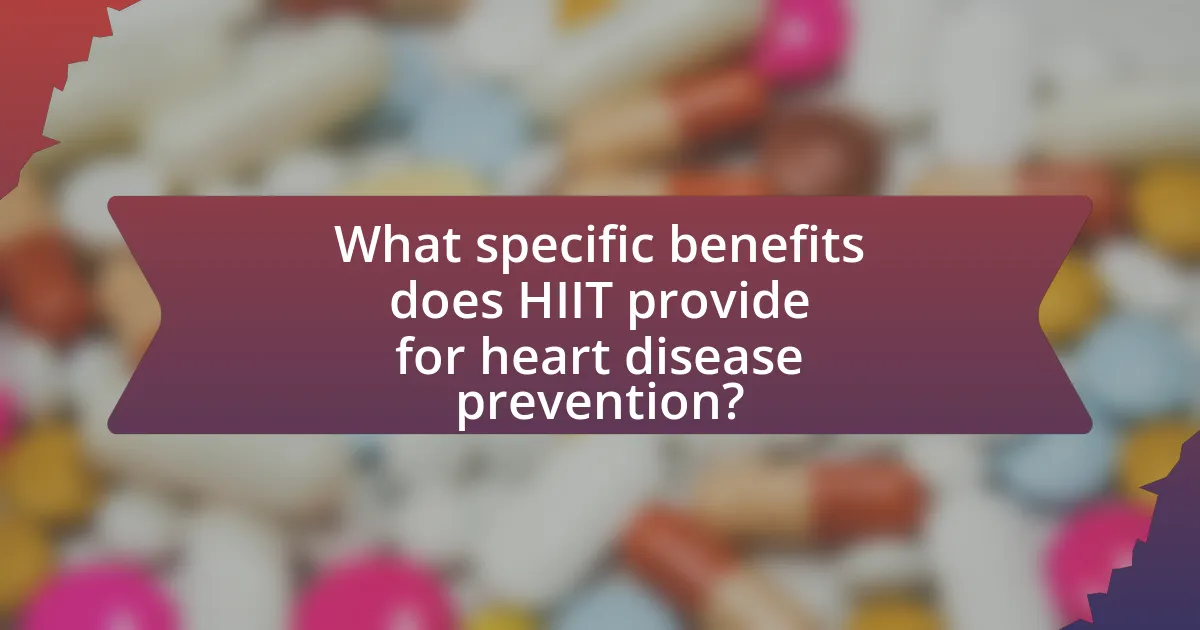
What specific benefits does HIIT provide for heart disease prevention?
High-Intensity Interval Training (HIIT) significantly reduces the risk of heart disease by improving cardiovascular health, enhancing metabolic function, and promoting weight loss. HIIT has been shown to increase cardiovascular fitness levels more effectively than moderate-intensity continuous exercise, as evidenced by a study published in the Journal of the American College of Cardiology, which found that participants engaging in HIIT experienced greater improvements in VO2 max, a key indicator of heart health. Additionally, HIIT can lower blood pressure and improve insulin sensitivity, both of which are critical factors in heart disease prevention. Research from the American Heart Association indicates that regular HIIT sessions can lead to substantial reductions in body fat percentage, further decreasing the likelihood of developing heart-related conditions.
How does HIIT improve cardiovascular fitness?
High-Intensity Interval Training (HIIT) improves cardiovascular fitness by significantly enhancing the heart’s efficiency and increasing aerobic capacity. This training method involves short bursts of intense exercise followed by rest or low-intensity periods, which stimulates the cardiovascular system more effectively than steady-state exercise. Research indicates that HIIT can lead to greater improvements in VO2 max, a key indicator of cardiovascular fitness, compared to traditional moderate-intensity training. A study published in the Journal of Physiology by Gibala et al. (2012) found that just two weeks of HIIT resulted in similar or greater improvements in cardiovascular health markers compared to longer durations of moderate exercise. This evidence supports the effectiveness of HIIT in enhancing cardiovascular fitness.
What physiological changes occur in the heart with HIIT?
High-Intensity Interval Training (HIIT) induces several physiological changes in the heart, primarily enhancing cardiovascular efficiency and function. These changes include increased stroke volume, improved cardiac output, and enhanced myocardial oxygen consumption. Research indicates that HIIT leads to greater improvements in left ventricular mass and function compared to moderate-intensity continuous training, as evidenced by a study published in the Journal of the American College of Cardiology, which found that participants engaging in HIIT exhibited a 10% increase in stroke volume and a 15% increase in cardiac output after a 12-week program. Additionally, HIIT promotes favorable adaptations in heart rate variability, indicating improved autonomic regulation of the heart.
How does HIIT affect blood pressure and cholesterol levels?
High-Intensity Interval Training (HIIT) significantly lowers blood pressure and improves cholesterol levels. Research indicates that HIIT can lead to reductions in systolic and diastolic blood pressure, with studies showing decreases of approximately 5-10 mmHg in hypertensive individuals. Additionally, HIIT has been associated with increased levels of high-density lipoprotein (HDL) cholesterol, which is beneficial for heart health, while also reducing low-density lipoprotein (LDL) cholesterol and triglycerides. A meta-analysis published in the Journal of the American College of Cardiology found that HIIT effectively improves lipid profiles and blood pressure in various populations, reinforcing its role in heart disease prevention.
What psychological benefits does HIIT offer for heart health?
High-Intensity Interval Training (HIIT) offers significant psychological benefits that positively impact heart health, primarily by reducing stress and anxiety levels. Engaging in HIIT has been shown to release endorphins, which enhance mood and promote a sense of well-being. Research indicates that regular participation in HIIT can lead to lower levels of cortisol, the stress hormone, thereby mitigating stress-related cardiovascular risks. Additionally, a study published in the Journal of Clinical Psychology found that individuals who engaged in HIIT reported improved self-esteem and reduced symptoms of depression, both of which are linked to better heart health outcomes. These psychological improvements contribute to a more active lifestyle, further supporting cardiovascular health.
How can HIIT influence mental well-being and motivation for exercise?
High-Intensity Interval Training (HIIT) can significantly enhance mental well-being and motivation for exercise by promoting the release of endorphins and improving mood. Research indicates that engaging in HIIT can lead to increased feelings of happiness and reduced symptoms of anxiety and depression, as evidenced by a study published in the Journal of Clinical Psychology, which found that participants who performed HIIT reported greater improvements in mood compared to those who engaged in moderate-intensity exercise. Additionally, the time-efficient nature of HIIT can boost motivation, as individuals often perceive it as a more manageable workout option, leading to higher adherence rates. This combination of mood enhancement and practical workout structure contributes to a more positive attitude towards regular exercise.
What role does enjoyment play in adherence to HIIT programs?
Enjoyment significantly enhances adherence to HIIT programs. When individuals find pleasure in their workouts, they are more likely to consistently participate in the training, leading to better long-term outcomes. Research indicates that enjoyment is a key predictor of exercise adherence, with studies showing that participants who enjoy their workouts are more likely to stick with them over time. For instance, a study published in the Journal of Sport and Exercise Psychology found that enjoyment directly correlates with increased frequency of exercise sessions among HIIT participants. This suggests that incorporating enjoyable elements into HIIT can improve adherence rates, ultimately contributing to the effectiveness of HIIT in heart disease prevention.
What are the potential risks associated with HIIT for heart disease prevention?
High-Intensity Interval Training (HIIT) poses several potential risks for individuals aiming to prevent heart disease. These risks include cardiovascular strain, which can lead to arrhythmias or other heart complications, particularly in those with pre-existing conditions. A study published in the Journal of the American College of Cardiology found that individuals with underlying heart issues may experience adverse events during intense exercise, highlighting the importance of medical screening before engaging in HIIT. Additionally, improper technique or overexertion during HIIT can result in musculoskeletal injuries, which may indirectly affect cardiovascular health by limiting physical activity. Therefore, while HIIT can be beneficial for heart disease prevention, it is crucial to approach it with caution, especially for those at risk.
Who should avoid HIIT or consult a physician before starting?
Individuals with pre-existing cardiovascular conditions, those with a history of heart disease, and individuals who are significantly overweight or sedentary should avoid HIIT or consult a physician before starting. Research indicates that high-intensity workouts can place excessive strain on the heart, particularly for those with underlying health issues. The American Heart Association recommends that individuals with these risk factors seek medical advice to ensure safety and appropriate exercise recommendations.
What are common injuries or issues that can arise from HIIT?
Common injuries or issues that can arise from High-Intensity Interval Training (HIIT) include muscle strains, joint pain, and cardiovascular complications. Muscle strains often occur due to the rapid and intense movements involved in HIIT, which can exceed an individual’s current fitness level. Joint pain may result from improper form or overuse, particularly in high-impact exercises. Additionally, cardiovascular complications, such as elevated heart rates and blood pressure, can occur, especially in individuals with pre-existing heart conditions. Research indicates that approximately 30% of individuals participating in HIIT report some form of injury, highlighting the importance of proper technique and gradual progression in intensity.
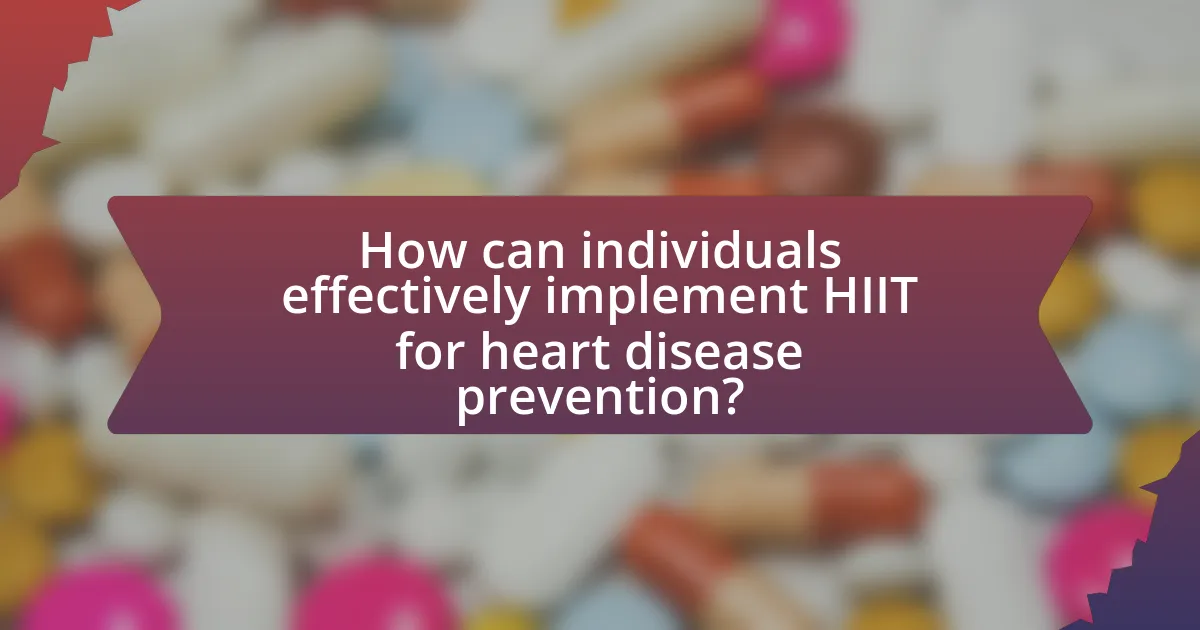
How can individuals effectively implement HIIT for heart disease prevention?
Individuals can effectively implement High-Intensity Interval Training (HIIT) for heart disease prevention by incorporating short bursts of intense exercise followed by recovery periods into their workout routines. Research indicates that HIIT can improve cardiovascular health by enhancing heart function, reducing blood pressure, and improving lipid profiles. For example, a study published in the Journal of the American College of Cardiology found that participants who engaged in HIIT showed significant improvements in cardiovascular fitness and reductions in body fat, both of which are critical factors in heart disease prevention. To implement HIIT, individuals should start with a warm-up, then alternate between 20-30 seconds of high-intensity exercise (like sprinting or cycling) and 1-2 minutes of lower-intensity recovery, repeating this cycle for 15-30 minutes, several times a week.
What are some practical tips for starting a HIIT program?
To start a High-Intensity Interval Training (HIIT) program effectively, begin by selecting exercises that you enjoy and can perform safely, such as sprinting, cycling, or bodyweight movements. Incorporate short bursts of high-intensity effort, typically lasting 20 to 30 seconds, followed by a recovery period of equal or longer duration. Gradually increase the intensity and duration of the intervals as your fitness improves. Research indicates that HIIT can significantly enhance cardiovascular health, with studies showing improvements in heart function and reduced risk factors for heart disease. For instance, a study published in the Journal of the American College of Cardiology found that participants engaging in HIIT experienced greater reductions in body fat and improved cardiovascular fitness compared to those performing moderate-intensity continuous training.
How can beginners safely approach HIIT workouts?
Beginners can safely approach HIIT workouts by starting with low-intensity intervals and gradually increasing intensity as their fitness level improves. This method allows beginners to adapt to the physical demands of HIIT while minimizing the risk of injury. Research indicates that a gradual increase in intensity can enhance cardiovascular fitness without overwhelming the body, making it a safer option for those new to high-intensity training. Additionally, incorporating proper warm-up and cool-down routines is essential to prepare the body for exertion and aid recovery, further supporting safe participation in HIIT workouts.
What resources are available for guided HIIT sessions?
Guided HIIT sessions are available through various resources including fitness apps, online platforms, and personal trainers. Popular fitness apps like Nike Training Club and Fitbit Coach offer structured HIIT workouts with video demonstrations and audio cues. Online platforms such as YouTube feature channels dedicated to HIIT, providing free guided sessions led by certified trainers. Additionally, personal trainers can create customized HIIT programs tailored to individual fitness levels and goals, ensuring proper technique and motivation. These resources collectively support effective HIIT training, which has been shown to improve cardiovascular health and reduce heart disease risk.
What are some common misconceptions about HIIT and heart health?
Common misconceptions about High-Intensity Interval Training (HIIT) and heart health include the belief that HIIT is only suitable for elite athletes and that it significantly increases the risk of heart problems. In reality, HIIT can be adapted for various fitness levels, making it accessible for many individuals, including those with existing health conditions. Research published in the Journal of the American College of Cardiology indicates that HIIT can improve cardiovascular health markers, such as VO2 max and blood pressure, without posing excessive risks when performed correctly. Additionally, some people mistakenly think that HIIT is detrimental to heart health due to its intensity; however, studies show that it can enhance heart function and efficiency, promoting overall cardiovascular health.
Why do some people believe HIIT is not suitable for everyone?
Some people believe HIIT is not suitable for everyone due to its intense nature, which can pose risks for individuals with certain health conditions. For instance, those with cardiovascular issues, joint problems, or other chronic illnesses may find the high-impact exercises exacerbating their conditions. Research indicates that individuals with pre-existing health concerns should consult healthcare professionals before engaging in such rigorous training, as the American Heart Association highlights the importance of tailored exercise programs for different health statuses.
How can misinformation about HIIT be addressed?
Misinformation about High-Intensity Interval Training (HIIT) can be addressed through education and evidence-based communication. Providing accurate information from credible sources, such as peer-reviewed studies, can clarify misconceptions. For instance, research published in the Journal of the American College of Cardiology demonstrates that HIIT can improve cardiovascular health and is effective for heart disease prevention. By disseminating findings from reputable studies, health professionals can counter false claims and promote a better understanding of HIIT’s benefits and safety.
What are the best practices for maximizing the benefits of HIIT?
To maximize the benefits of High-Intensity Interval Training (HIIT), individuals should focus on incorporating varied intervals, maintaining proper form, and ensuring adequate recovery. Varied intervals, such as alternating between short bursts of maximum effort and longer recovery periods, enhance cardiovascular fitness and metabolic rate. Maintaining proper form during exercises prevents injuries and ensures effective muscle engagement, which is crucial for achieving desired fitness outcomes. Adequate recovery, including rest days and active recovery sessions, allows the body to repair and adapt, ultimately improving performance and reducing the risk of overtraining. Research indicates that following these practices can lead to significant improvements in cardiovascular health and overall fitness levels, supporting the role of HIIT in heart disease prevention.
How can individuals track their progress in HIIT?
Individuals can track their progress in High-Intensity Interval Training (HIIT) by monitoring key performance metrics such as workout duration, intensity levels, heart rate, and recovery times. Tracking these metrics allows individuals to assess improvements in fitness levels and endurance over time. For instance, studies indicate that consistent tracking of heart rate during HIIT can help individuals maintain optimal intensity, which is crucial for cardiovascular benefits. Additionally, using fitness apps or wearable devices can provide real-time data and historical trends, enabling users to visualize their progress and make necessary adjustments to their training regimen.
What should be included in a balanced fitness routine alongside HIIT?
A balanced fitness routine alongside HIIT should include strength training, flexibility exercises, and steady-state cardio. Strength training, such as weight lifting or bodyweight exercises, enhances muscle mass and metabolism, which is crucial for overall health. Flexibility exercises, like yoga or stretching, improve range of motion and reduce injury risk. Steady-state cardio, such as jogging or cycling at a moderate pace, complements HIIT by promoting cardiovascular endurance and recovery. Research indicates that combining these elements can lead to improved heart health and reduced risk of heart disease, as supported by findings from the American Heart Association.
